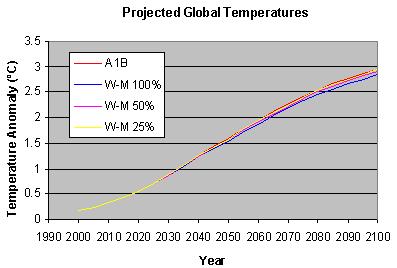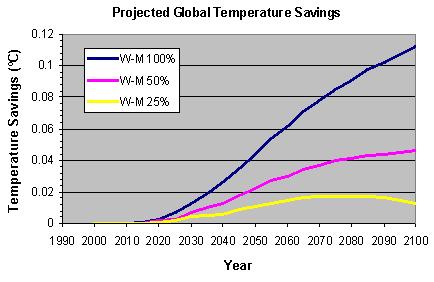“Dirty” Waxman-Markey: How Small Can Small Get?
By Chip Knappenberger -- May 11, 2009“Binding emissions targets for the developing nations are out of the question.”
– Eileen Claussen, Pew Center on Global Climate Change, March 2009
As I demonstrated in my analyses last week (here and here), the impact on global temperatures of U.S. actions to reduce greenhouse gas emissions pursuant to the Waxman-Markey climate bill (which called for a whopping 83% reduction by 2050) was close to nil. Or more precisely, about 0.05°C (0.09°F) by the year 2050, expanding to maybe 0.1°C–0.2°C by the end of the century, depending on, among other things, which future emissions course is assumed as the baseline.
And as the negotiations continue into the specific details of the proposed legislation, the emission reduction schedule has begun to slip—and so too does the potential climate impact.
So what is the temperature impact of a dirty Waxman-Markey bill versus the “clean” bill’s 0.05°C/0.09°F? (Hint: divide by half and even half again.)
The answer is provided in Figure 1. This figure shows the projected global temperatures for the middle-of-the-road IPCC future emissions scenario (SRES A1B), along with the projected temperatures from three potential iterations of the Waxman-Markey climate legislation–a “clean” version (i.e., 100% of the original emissions reduction schedule), a “dirty” verision (i.e., 50% of the original emissions reduction schedule), and a “dirtier” version (i.e., only 25% of the original emissions reduction schedule). I used the same methodology for this analysis as I described here.
If you can’t tell the different lines in Figure 1 apart, join the club. The original Waxman-Markey emissions reduction schedule, as aggressive at it may seem, does so little to alter the projected course of future global temperatures, that dirtying up the bill makes the original next-to-nothing impacts even less (if that is possible).

Figure 1. Projected global temperatures from using the IPCC SRES A1B middle-of-the-road emissions scenario, and after adjusting that scenario to reflect the effects of three potential versions of the Waxman-Markey climate bill (100% of the reductions called for in the original draft, 50% of the reductions called for in the original draft, and 25% of the reductions called for in the original draft).
For those interested in the details, I present the global temperature “savings” resulting from my three Waxman-Markey versions in Figure 2. The temperature “savings” are computed as departures from the temperature projections from the IPCC’s original A1B scenario. Here you can see the projected Waxman-Markey climate impact in all its glory. By the year 2050, the “clean” version reduces projected global temperatures by 0.044ºC (or ~3% less than the rise without the legislation), the “dirty” version gets you about half of that, or 0.022ºC (~1.5% less), and the “dirtier” version saves half of that again, or 0.011ºC (<1% less). By century’s end, you don’t do much better–the temperature reduction amounts to, respectively, 0.112ºC (0.20ºF), 0.046ºC (0.08ºF), and 0.013ºC (0.02ºF).

Figure 2. Temperature “savings” resulting from potential versions of the Waxman-Markey climate bill.
None of these numbers represents a scientifically meaningful effect on the future of the global climate or on any impacts that may result from future climate change.
The conclusion of all this: the U.S. has no role to play in the projected course of global climate through domestic emissions reduction alone. And as the above quotation by Eileen Claussen of the Pew Center on Global Climate Change makes clear, those in know are forecasting that the U.S. would have to go it virtually alone.
This leads to the undeniable result that for the U.S. to have any meaningful impact in mitigating projected global temperature rise, it must come from our contributions to helping other countries reduce their emissions. But with record U.S. budget deficits and the oil, gas, and coal sectors roaring in the developed world, nil will certainly remain nil.
The only way this will change is with the development of new technologies, as existing ones are not up to the task, despite many promises from their advocates.
So while we work to develop a silver-bullet solution, turning attention from (ineffectual) mitigation to adaptation might be a strategy whose time has come.
Thanks for another great analysis, Chip.
Spending 2-4% of GDP ANNUALLY for an outcome that is less than natural climate variability will be one of the worst policies in terms of cost/benefit in the history of the U.S.
Doing so at a time of enormous economic expansion would be bad enough. Doing so while in a recession, or as the U.S. economy struggles to emerge from one, would be somewhere between sophomoric and down right stupid.
But remember, this isn’t about saving the planet, humans, animal species, or avoiding a humanitarian disaster. This is about global government coordination and control, about de-industrializing the industrialized world, about punishing capitalism, about punishing energy consumption, about punishing fossil fuels, about subsidizing the development of the developing world, and about funding wealth redistribution here in American to ensure more votes in 2010 and 2012.
And if you and your elected officials allow cap and trade or any form of carbon tax to become law, don’t be surprised if this is exactly what you get, in addition to a lower rate of economic growth, reduced personal wealth, higher energy bills, higher food prices, higher prices for all consumer goods, and more government intrusion into your choices (the car you drive, your electricity usage, and much more).
Wake up, America. And do it QUICK!
Considering that the original post triggered a bunch of “Yeah, but we won’t go it alone!” nonsense, the starting quote is apropos.
Carbonicus,
The investment required to actually reduce carbon emissions by 83% by 2050 would be ~4.9% of GDP each year, without the impact of a carbon tax or allowance auction.
[…] out only about 3 percent of the human influence on climate (according to IPCC model projections), equating to about 0.09°F, this is an insurance policy with virtually no redemption […]
[…] he has nothing on!” cried a small, but persistent voice. “His expensive ideas do nothing to change the […]
[…] Foundation analysis is here, and MasterSource, a free market energy site, is here. Category: Economics, Energy, Global Warming, Politics You can follow any responses to this entry […]
[…] blog, Masterresource.Org has written brilliantly and extensively on these matters (see here, here, here, here, and […]